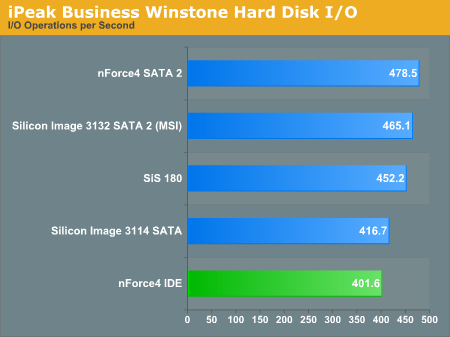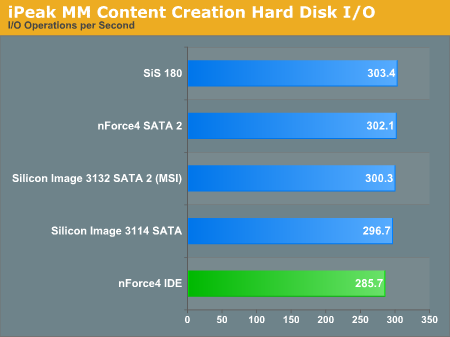nForce4 Ultra Roundup: Charting the Mainstream
by Wesley Fink on July 5, 2005 10:28 PM EST- Posted in
- Motherboards
Disk Controller Performance
With so many storage controllers on the nForce4 SLI boards, we needed a means of comparing performance of the wide variety of controllers. The logical choice was Anand's storage benchmark first described in Q2 2004 Desktop Hard Drive Comparison: WD Raptor vs the World. To refresh your memory, the iPeak test was designed to measure "pure" hard disk performance, and in this case, we kept the hard drive as consistent as possible while varying the hard drive controller. The idea is to measure the performance of a hard drive controller with a consistent hard drive. We played back Anand's raw files that recorded I/O operations when running a real world benchmark - the entire Winstone 2004 suite. Intel's IPEAK utility was then used to play back the trace of all the IO operations that took place during a single run of Business Winstone 2004 and MCC Winstone 2004. To try to isolate performance difference to the controllers that we were testing, we used Seagate 7200.7 model SATA and IDE hard drives for all tests.iPeak gives a mean service time in milliseconds; in other words, the average time that each drive took to fulfill each IO operation. In order to make the data more understandable, we report the scores as an average number of IO operations per second so that higher scores translate into better performance. This number is meaningless as far as hard disk performance is concerned as it is just the number of IO operations completed in a second. However, the scores are useful for comparing "pure" performance of the storage controllers in this case.


The Silicon Image 3114 controller is only a bit slower in MM Content IO, but it quite a bit slower in Business IO. The 3114 does uniquely feature RAID 3 capabilities.
IDE provided the slowest IO performance in this roundup, demonstrating that SATA controllers are finally starting to show a performance edge - at least in IO operations.
We also plan to include IDE RAID and SATA RAID benchmarks in future motherboard tests. Comparing RAID performance on various controllers will definitely be a part of future storage benchmarking and possibly motherboard tests as well as new on-board RAID controllers that are introduced.










75 Comments
View All Comments
yacoub - Wednesday, July 6, 2005 - link
#33 - Wesley, that's awesome news. Can you post that somewhere more important so buyers know to be on the lookout for it? =)kyparrish - Wednesday, July 6, 2005 - link
Good article!I'm seriously considering dumping my DFI S754/NC 3200+ setup for that Epox board and a cheap S939 A64 :)
Wesley Fink - Wednesday, July 6, 2005 - link
#29 and #31 - UPDATE: I have talked with contacts in the Memory Industry and Samsung TCCD is now available again from Samsung. TCCD disappeared for a few months but production didn't really stop. TCC5 is DDR466 and TCCD is DDR500, but both chips come off the same line and are binned for speed grade. Samsung stopped binning for DDR500 grade until recently - and left this job to the memory makers.Recently Samsung has told memory makers they are binning once again for DDR500/TCCD and the TCCD chips are available again. It will take a few weeks for the pipelines to fill but TCCD is not dead. Some companies are staying with TCC5 at a lower cost and binning for the top performance unless the yields start to go down.
Wesley Fink - Wednesday, July 6, 2005 - link
#24 - The base nForce4 is sometimes called the nForce4 X4 and runs at 800 HTT, while the Ultra and SLI run at 1000HT. When 1000HT was first introduced we found no real difference in performance at 800HT and 1000HT. What the 1000HT did provide was quite a bit more overclocking headroom. A reader may have an example of where 1000HT outperforms 800HT but the real world difference is negligible.#28 - There are now more than 60 BIOS releases for the DFI nF4, many customized for particular memory types. Only 3 have been posted to their website. For the latest DFI nF4 BIOS a good place to check is www.xtremesystems.org or the BIOS Files Forum at www.bleedinedge.com. There is now a 7/04 BIOS that is reported to be more stable in upper memory ratios (433,466,500) with Rev. E chips.
#29 - You are overstating the TCCD situation. Corsair still sells TCCD, as do several other memory vendors. There is no doubt TCCD is drying up everywhere but Corsair, and that will continue. New TCC5 dimms that are said to perform like TCCD are in process in at least one memory company. We have requested these new TCC5-based dimms and will share our findings as soon as we receive the memory. There are also some new BH5 dimms that we thought were gone forever. We have even seen the new BH5 binned and advertised as DDR500 2-2-2 at higher voltages around 3.3V.
yacoub - Wednesday, July 6, 2005 - link
Well, while this review -has- convinced me to go with the DFI board over the Chaintech, that is purely due to the audio CPU usage issues of the onboard vs daughterboard. I'm shocked at how much difference that makes.That said, most of the memory testing (and thus most of the review) was meaningless to me (and everyone else who doesn't have access to TCCD memory anymore). =/
Wesley Fink - Wednesday, July 6, 2005 - link
#17 - Thanks for pointing out the errors. They have been corrected. Do you want a job proof reading :-)yacoub - Wednesday, July 6, 2005 - link
Regarding the tRAS recommendation:Can we petition Anandtech to stop using memory that the consumer can't get anymore? (Namely TCCD-based Plat Rev2.) Go pick up some TCC5 and do your tests with what the consumer is actually going to be receiving so your tests actually mean something.
mongoosesRawesome - Wednesday, July 6, 2005 - link
What BIOS version did you use with the DFI? It reads: "Award 7/01/2005 Release" in your list of features for the DFI, but I could not find that BIOS release on their website.AsiLuc - Wednesday, July 6, 2005 - link
Sorry I meant: GA-K8NF9http://www.giga-byte.com/MotherBoard/Products/Prod...
AsiLuc - Wednesday, July 6, 2005 - link
I'd liked to see the Gigabyte GA-K8NP9 reviewed, because it has passive southbridge cooling (silence :) ) and is cheap.